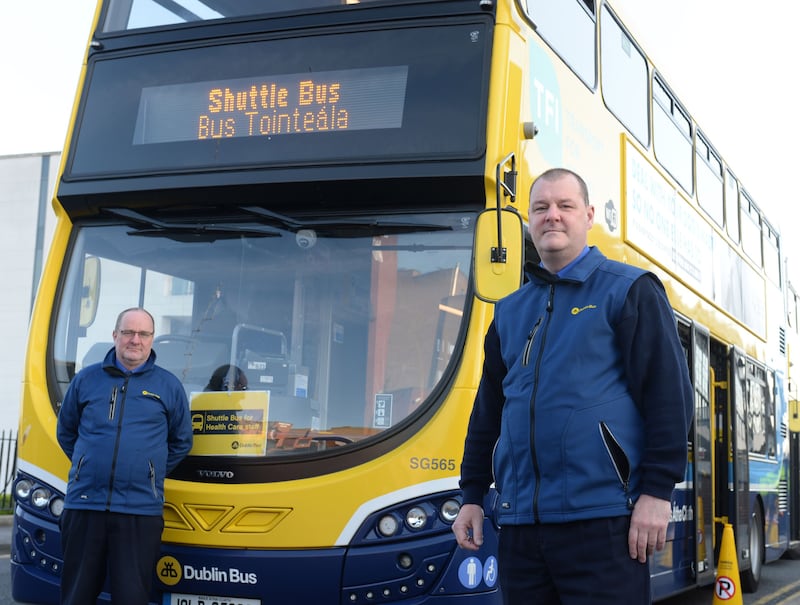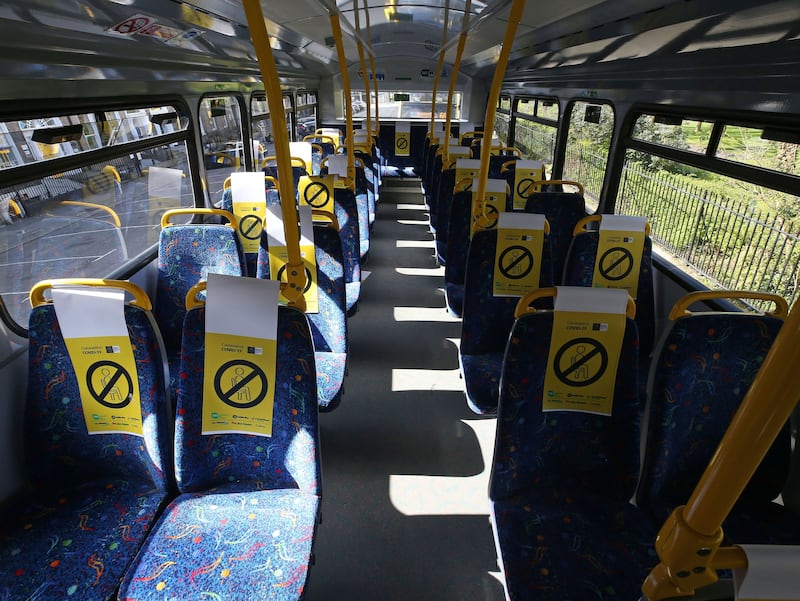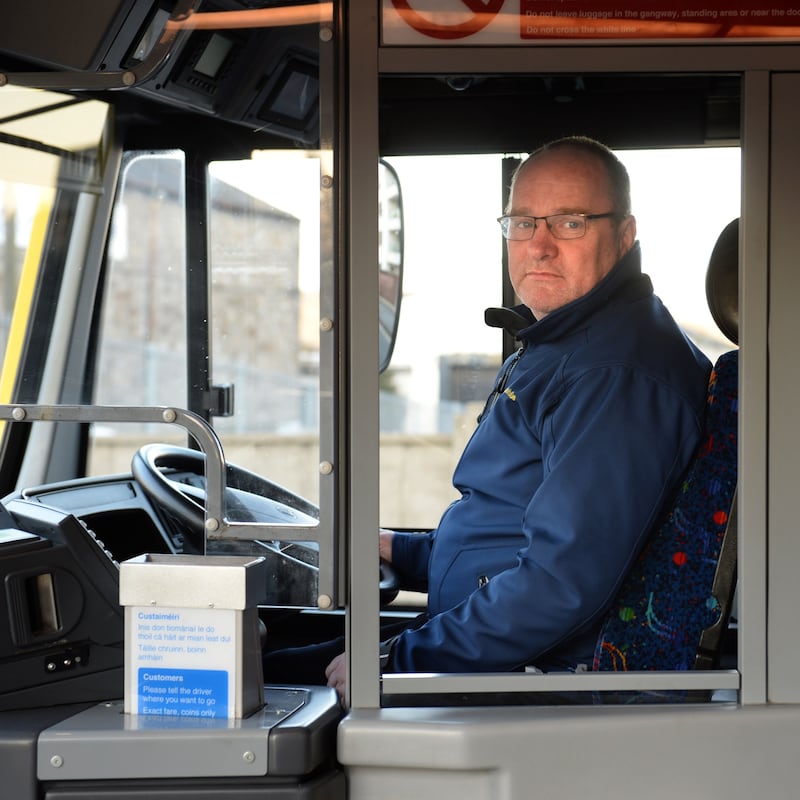Just before nine on a weekday morning I take a 123 bus from the suburb of Marino into Dublin's city centre. It's the first time I've been on a bus in over a month. Dublin Bus is still running what they call a "Saturday-plus service" which means that they're running Saturday hours with additional early morning buses for essential workers.
It’s all very strange. The screen between the bus driver and the passengers is raised and a plastic sheet is stuck across the holes in its centre. There are yellow signs marking all the seats on which passengers are expected not to sit. Six people can sit on the ground floor.
There is one other person on the bus when I enter and two others – one wearing a face mask – board between Marino and the journey to Dame Street in the city centre. The bus has a sort of “just new” smell, probably due to the fact each bus is intensively cleaned at least twice a day now, to ward against the spread of coronavirus.
The strangest place now is actually out in UCD because you'd normally have 30 or 40 people at that stop waiting to go to the city centre
It's a very sunny morning and the sun glitters along the canal as we cross it at Ballybough. There are a couple of vehicles on the road as the bus glides without stopping through Summerhill. As we move from the suburbs to the city centre the sporadic sight of people walking for their daily exercise is replaced by people walking more purposefully, as though heading to work. A man and a boy are jogging down the middle of the road on O'Connell Street. Some dishevelled lost-looking people carry sleeping bags. Two Deliveroo cyclists rest at the base of the Grattan statue across from Trinity College. There's a moment, on Dame Street after I disembark, when the street is completely empty of cars and people and I can hear birds.
"It's eerie out there," says Mick Kelly, who has driven for Dublin Bus for 25 years and drives the 84 bus. "There's nobody out. There's no traffic around you. It feels like that film 28 Days Later."
I meet Kelly and another driver named Sean O'Reilly at 7.45am on Jones' Road, beside Croke Park. Bus drivers, like medical workers, care workers, shop assistants and warehouse workers, are on the frontline, keeping some semblance of normality for people in the lockdown. In London, 12 bus workers have died of coronavirus. Thankfully there have been no such reports in Dublin, though the Dublin Bus press office say that for patient confidentiality it will not be releasing the number of Covid-19 cases "if any" among their drivers.

Kelly and O'Reilly, who usually drives the 39 from Ongar, an outer suburb in west Dublin, to UCD on the southside, are also tour drivers on Dublin Bus's sightseeing tours. Those dried up, Kelly says, as soon as the pandemic was in the news, well before the shutdown. They've been seconded to another gig driving a shuttle bus for Mater hospital workers to and from GAA-donated parking spaces at Croke Park. This service operates from 6.30am until 10am and from 4pm until 9pm.
Dublin Bus is also pitching in with other things. It also provides a driver to help the Daughters of Charity on Henrietta Street in the city centre to deliver meals on wheels to senior citizens.
O’Reilly wants to ensure we’re all two metres apart for social distancing purposes. “I socially distance from Sean anyway,” says Kelly.
“Don’t be like that!” says O’Reilly. “I just got you a Snack bar.”
Kelly and O’Reilly like their jobs. O’Reilly was formerly a chef and Kelly was once a barman. Later, O’Reilly says, “I don’t think I could go back to . . .”
“Were you going to say, ‘working’?” says Kelly.
There are Garda checkpoints where the guards get on the bus and check upstairs and downstairs to check where passengers are going and what their business is
What's it like out on the roads at the moment? "It's strange because we're so used to the congestion," says O'Reilly. "The 39 is one of the busiest fleets . . . So usually you have a full bus coming into town and then it's empty by Bachelors Walk and it's full again by Nassau Street. But this reminds me of working Stephen's Day or Good Friday when nobody is working. The strangest place now is actually out in UCD because you'd normally have 30 or 40 people at that stop waiting to go to the city centre."
Who is still travelling? “There are obviously the health workers but there are also people working in service industries, in shops,” says Kelly. “There are two postmen who get my bus every morning. You get to know the customers quite well. When you’re driving the bus you often go, ‘Pat’s not there, where’s Pat?’ The main group that’s disappeared are the older people. They’d come out and get the bus at 10 in the morning and go do a bit of shopping – I think it was a social thing – the same people every day at the same time. They’re all gone.”
Are there any people travelling who shouldn’t be travelling? “There are one or two you wonder ‘Where are they going?’” says Kelly. “But not many.”
“Sometimes you get the odd teenager,” says O’Reilly. “I think there’s a lot of social pressure on people to behave. And there are Garda checkpoints where the guards get on the bus and check upstairs and downstairs to check where passengers are going and what their business is.”

“People are very good at the social distancing,” says Kelly. “From time to time you might have to say, ‘Please don’t sit on a seat with a yellow tag.’ Sometimes they ask, ‘Can we sit together if we’re from the same house?’ and I say, ‘You probably shouldn’t because it will interfere with the seat pattern’ . . . Most people are fine with that.”
There’s a little less chat with customers as they board, he says. People are less inclined to talk and the drivers also have the screen up for self-protection. The screens were originally brought in during heroin epidemic in the 1990s, he says, when a number of drivers were robbed. Up until now he has resisted using the screen. “I felt it kind of created a division . . . I felt hemmed in. But I feel comfortable with it now and I might keep it up . . . I think when it’s all done, we’ll all have things we’ll do differently. What’s considered personal space will become bigger. I think handshaking for some people won’t be a thing anymore.” He laughs. “And the one I don’t get anyway myself are the huggers.”
Have they had any journeys with a completely empty bus? "Not totally empty but its first cousin," says Kelly. "I have driven a bus all the way from Newcastle [in south Co Dublin] to Blackrock and only carried three people. When we were busy all the time we'd go, 'God give me a break from that!' But this is too much."
When we're talking with each other over lunch it's like being in Shawshank Redemption
“You forget sometimes,” says O’Reilly. “Sometimes you pull in at the busy stops even though there’s no one there. You pull in because it’s in your nature.”
Do they miss the traffic? “When we’re in traffic we’re in work,” says O’Reilly. “We’re not in traffic on our way to work like everyone else.”
“I don’t miss it, but I really notice it’s not there,” says Kelly. “There’s no traffic to slow you down. So, there are extra time on either side at the terminus which prolongs the day a bit.”
Even break times are strange now, says O'Reilly. "Our canteen is behind Clerys and that's eerie in itself. There's social distancing so the table that usually seats four only seats two and there's a screen in the middle of the table. When we're talking with each other over lunch it's like being in Shawshank Redemption. You miss things like someone giving you the elbow when they're cracking a joke."

He’s taken to going for walks at lunch to little nooks and crannies in the city he hasn’t seen before. “I was walking through it there last week singing that song [Ghost Town by the Specials] . . . ‘This Town is turning to a ghost town.’ It’s very strange not to see the shops open.”
Are there many people still around? “There are homeless people in town and a lot of people are out walking because people live there too. But there’s not much hanging around because gardaí are moving people on . . . And there are all the seagulls.”
“The seagulls are wondering where their grub is,” says Kelly.
The shuttle service isn’t hugely busy this morning because it’s a sunny day and people are choosing to walk. There are two or three hospital staff members on each bus. A nurse sees my Dictaphone as she boards and says: “The drivers are very good. They gave us crisps and biscuits last week.”
They have been giving gifts to the hospital staff, explains chief inspector Tony Cavanagh. "Last week we had Easter eggs."
Kelly and O’Reilly talk about how their families are keeping occupied. Kelly’s wife is a nurse. O’Reilly’s seven-year-old had “her first meltdown, God love her, a few nights ago. ‘I’m sick of this coronavirus thing!’ So, I brought her out for a cycle to get her mind off it.”
Kelly tells us about an old RTÉ radio documentary he's been listening to in which a driver is talking about the early morning bus in the city.
“The first bus in the morning, it used to be called ‘the ghost bus’,” says O’Reilly.
They all look like ghost buses now, I say. Kelly laughs. “They’re all ghost buses now.”

















